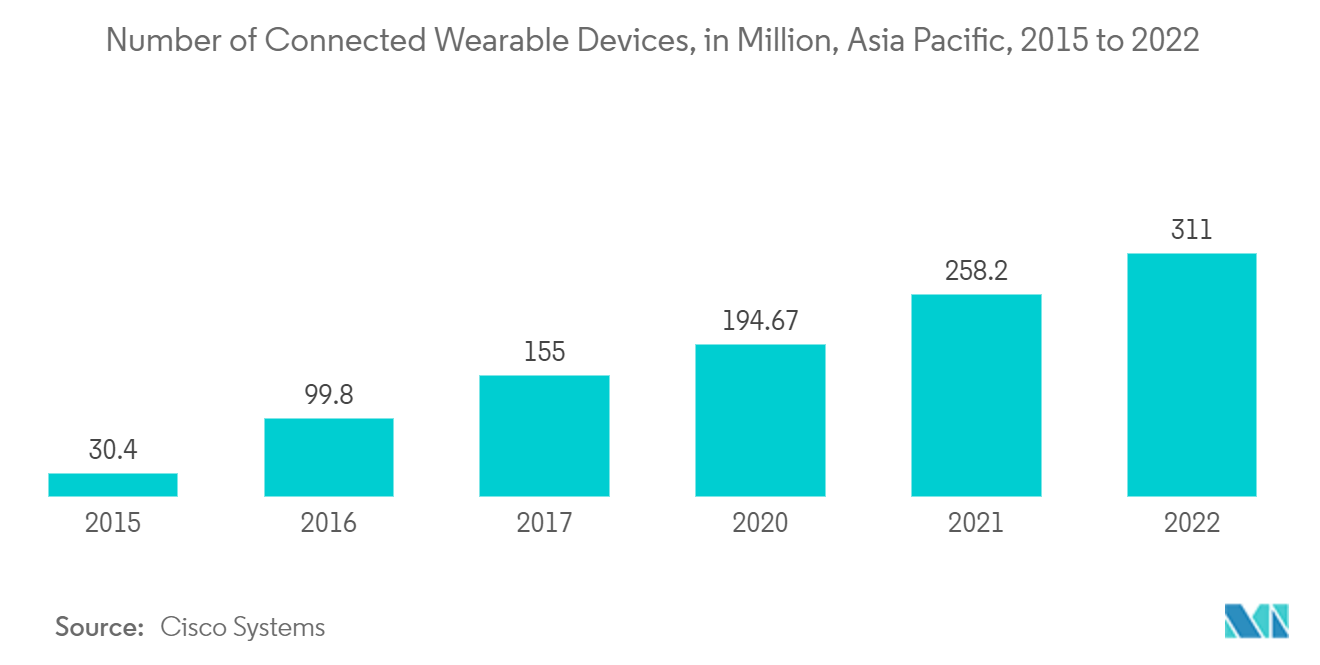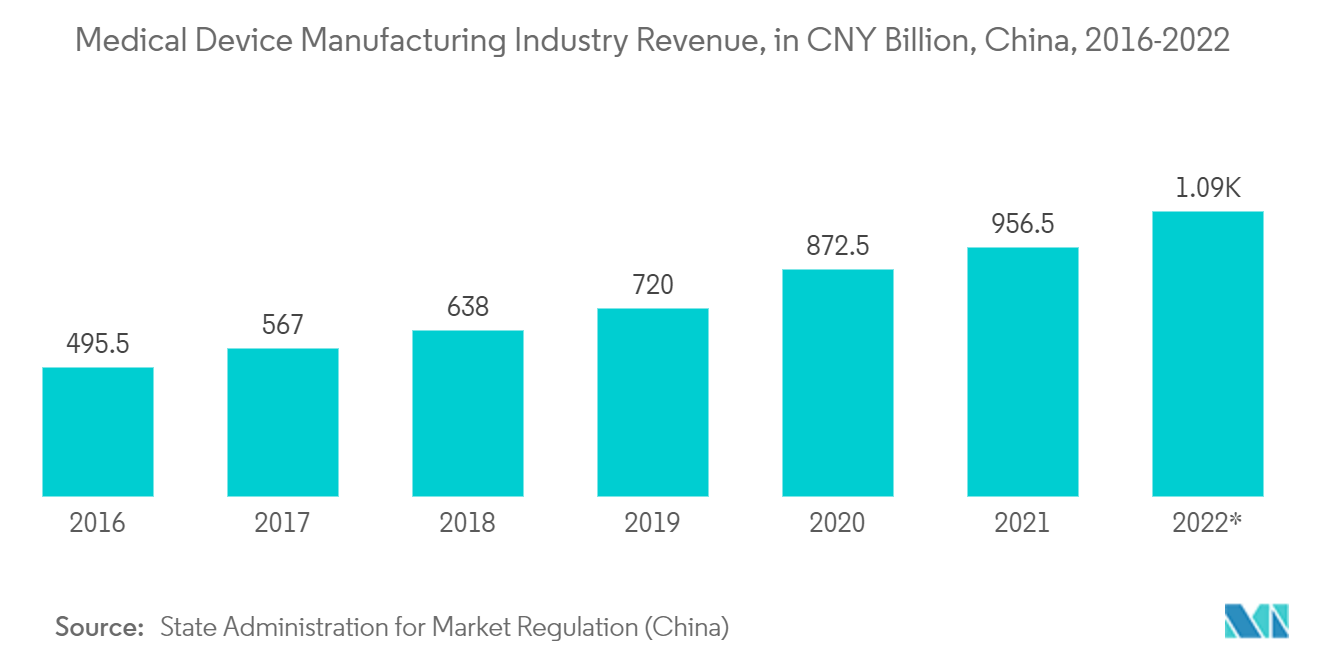Market Trends of Asia-Pacific Biomedical Sensors Industry
This section covers the major market trends shaping the APAC Biomedical Sensors Market according to our research experts:
Growing Demand for Fitness Devices
- A fitness tracker is an electronic device for tracking and monitoring fitness-related metrics such as distance walking or running, calories burned, heartbeats, and many others. It is a type of wearable computer, also known as an activity tracker, which is usually embedded with various sensors such as an accelerometer (to track movement), a gyroscope (to measure orientation and rotation), an altimeter (to sense changes in altitude), an electrocardiogram (to record electric impulse of the heart), pulse oximeter (to track oxygen in various parts), etc.
- Further, the growing product innovations in wearables integrated with health sensors may boost the market's growth during the forecast period. For instance, recently, Apple announced the launch of the Apple Watch Series 7. The new Apple Watch includes an electrical heart sensor, an ECG app, and a Blood Oxygen sensor and app, which are essential tools for health and wellness. New workout types in watchOS eight help users stay healthy, active, and connected.
- Fitbit Inc. launched the Fitbit Sense, an advanced health smartwatch embedded with an innovative sensor, software technology, and the first electrodermal activity (EDA) sensor to help manage stress, along with advanced heart rate tracking technology, a new ECG app, and an on-wrist skin temperature sensor, all powered by 6+ days of battery life. The company stated that the activity tracker would be loaded with a broader range of sensors to collect data that could save lives, diagnose illnesses, and keep doctors constantly updated about their patient's whereabouts.
- In May last year, Huawei announced the Huawei Band 7, the newest wearable technology. The gadget is the thinnest fitness tracker. The wearable device is available in two versions: Standard and NFC. The NFC model costs CNY 309 (USD 45), while the standard model is priced at CNY 269 (USD 40). Wild Green, Flame Red, Obsidian Black, and Nebula Pink are the available color options.
- According to Cisco Systems, 311 million connections in Asia-Pacific would be 156 million more than those made in 2017. Fitness bands communicate via Bluetooth with applications in a mobile device (smartphone) that configures the device and downloads the wearer's activity data. Most smartwatches support several physical activities via a health application. Sensors within fitness trackers have improved dramatically in recent years. They offer accurate heart rate monitors, accelerometers to detect minor changes in movement or positioning, and ECG sensors in devices like the Samsung Galaxy Watch Active 2, Apple Watch, and Amazfit Verge 2, which increased awareness of any issues within the heart.

Temperature Sensor is Expected to Hold a Major Share
- Medical applications of temperature sensors are vast. The most common use is a thermometer to measure the temperature of individuals quickly and accurately. However, they are also used for various medical products, including MRI equipment and portable ultrasound scanners. NTC (negative thermal coefficient) thermistors are standard temperature sensors that measure skin surface temperature. For medical applications, multiple variants are available with the right angle or straight connectors to simplify installation. Typical applications for this type of temperature sensor include adult rectal, pediatric rectal, and skin probes. Specific designs are capable of withstanding 134°C autoclavable cycles.
- Infrared (IR) temperature sensors do accurate non-contact temperature measurements in several medical applications. The most common temperature sensor applications measure ear, forehead, or skin temperature. The sensing element comprises multiple thermocouples on a silicon chip to measure an object's infrared energy. Temperature sensors are being introduced with IoT connectivity to considerably speed up COVID-19 screening. Several companies are joining forces to develop a series of human body temperature monitoring wearable devices. The wearable devices' sensors provide real-time data to frontline healthcare workers and allow them to quickly screen individuals with a high temperature, one of the most prominent symptoms of COVID-19.
- In healthcare institutions, the medication's temperature in refrigerators is often recorded manually. In practice, this means that an institution employee goes through all the refrigerators daily to check and register the temperature of the medication. This data is then manually entered into the system. It is a cumbersome, time-consuming, and expensive process for healthcare institutions with multiple locations and can be done more efficiently using temperature sensors.
- According to the State Administration for Market Regulation (China), the overall revenue of the Chinese medical device manufacturing industry was CNY 873 billion (USD 125 billion) two years back, reflecting a 21% Y-o-Y increase. The country's total revenue from medical equipment manufacturers was expected to exceed CNY 1 trillion (USD 145 billion) by last year. Such an increase in medical devices is expected to drive the temperature sensors
- In June last year, researchers from the Korea Advanced Institute of Science and Technology (KAIST) created an ultra-sensitive sensor platform that can measure human body temperature in real-time using only the naked eye and without the assistance of electronic gadgets. The device monitors temperature by color change by electrospinning a temperature-sensitive color-changing dye onto a nanofiber membrane.

